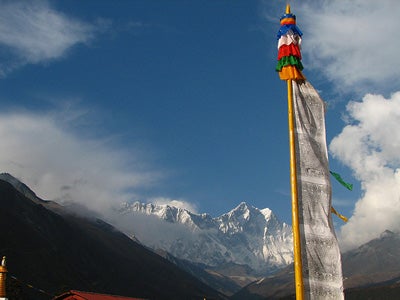Sherpas To Everest Flies: 'Buzz Off!'

You would think at 17,585 feet you could escape pesky houseflies. Not so true anymore: Twice this year, Dawa Steven Sherpa has experienced the strange and previously-unheard-of sound of buzzing at Everest’s base camp.
Dawa says seeing flies a few years ago would’ve been unimaginable. He blames a warming trend in the Himalayas for the sightings, in addition to several other frightening changes to the area’s geography.
“What I do is climb. It’s a family business. And what we see is the Himalayan glaciers melting. It’s not a seasonal thing any more. It’s rapid. It’s so apparent.
“Look at the walls and slopes of the Khumbu glacier [which flows 1.5 miles down from an icefall on the southern flanks of Everest]. “You can see a clear line where the black rock becomes white. That’s where it’s been exposed to the sun. That means meters of thick ice have melted in just a few decades,” he says.
Dawa, who comes from a family of Himalayan climbers, says it’s not just the mountain that the warming temps are effecting, it’s life for the people that live there, too. From prolonged drought and erratic weather patters to the dangerous threat of glacial lake outburst floods (glofs), everyone is feeling (forgive the pun) the heat of this warming trend.
Dawa sights a crucial example: “Imja Lake is the most dramatic example of a potential one. It is growing 74m a year. When it bursts its banks, we will have a mountain tsunami. Billions of gallons of water will be released and it could wipe out about 70% of the trekking trail to Everest base camp. Not only will that destroy our homes and potentially kill people, but it will wipe out the jewel in the crown of Nepal’s tourism industry,” he says.
This already happened on a smaller scale: Last year a small lake on the edge of Khumbu Glacier burst and washed away four bridges on one of the tracks to Everest’s base camp. Apa Sherpa, world record holder for most summits of Everest (19), agrees with Dawa. He most recently reported seeing water running on the South Col (a saddle at 25,984ft between Everest and Lhost mountain)—a first for so high up the mountain.
Dawa also says the cornice of Everest is beginning to break off, and a large crevasse is opening up. “It seems nothing is safe anymore,” Dawa said.
While it seems natural that mountains will eventually fall, glaciers will melt, and natural disasters will happen even without human interference, the rapid appearance of flies serves as a particularly annoying wake-up call. Somebody get Al Gore a fly swatter.
–Jordan Olmsted
Himalayan Sherpas Bugged By The Sight Of House Flies At 5,000m (The Guardian)